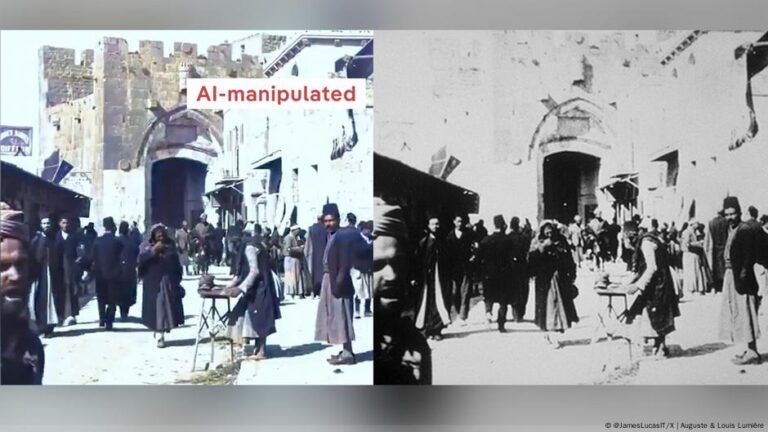A vibrant video showing a bustling street scene in Jerusalem from 1897 has captivated numerous users on the social media platform X. The clip, which appears to depict the Jaffa gate , shows people walking through the frame in full color — and has prompted both fascination and skepticism. While some users marvel at the historical glimpse, others question its authenticity, wondering whether footage could exist from that era or whether it’s AI-generated. Others point out that there were no videos back in 1897.
DW Fact check took a closer look at the video.
A glimpse into the past?
The video does indeed portray the Jaffa Gate in Jerusalem, and remarkably, the gate and surrounding buildings still resemble those seen in the clip.
A reverse image search reveals that the original footage was filmed by French cinematographer Alexandre Promio in 1897, for a short film entitled “Jerusalem, porte de Jaffa, cote est” (“Jaffa Gate East Side”).
This information was confirmed by Michael Allan, Associate Professor of Comparative Literature at the University of Oregon, who has dedicated himself to this exact period of cinematic history.
The original film, like most from that time, was black and white and silent. The version circulating online has been digitally colorized and enhanced, to breathe new life into the historic scene.
Further research links the footage to a catalogof motion pictures created by the pioneering Lumiere brothers that includes the exact scene from 1897.
How real footage is discredited
Despite its traceable origins, the video currently circulating online blurs the line between real and artificial. While no one sharing or commenting on the clip is necessarily spreading misinformation, the enhancements — colorization, added sound, and motion correction — raise questions about authenticity.
The original black and white footage from 1897 has been enhanced through colorization, and additional sound that was not previously present has been potentially added with the help of artificial Intelligence.
Additionally, “the motion of the image seems to have been ‘corrected’ to adjust and render more consistent the movements of those depicted onscreen”, Allan wrote to DW.
He added that even a version included in aDVD entitled The Lumiere Brothers’ First Films has been restored, prompting reflection on what “real footage” truly means. He described this phenomenon as an effet de reel — or effect of style, a device that can be used to resonate with contemporary audiences. “Viewing conditions evolve with each iterative variation of these films,” Allan told DW, suggesting that such enhancements could give historical footage a kind of afterlife.
The double-edged sword of digital restoration
The allure of colorized historical footage is not new. In 2018, the New Zealand filmmaker Peter Jackson used similar techniques to produce They Shall Not Grow Old, a documentary featuring restored and colorized footage from World War I.
However, AI has also been misused — for example, to create fabricated images of Auschwitz, distorting the historical memory of the Holocaust.
This raises a critical issue: the danger of circulating falsified content under the guise of authenticity. According to the German newsletter Social Media Watchblog (SMWB) , another risk lies in discrediting genuine content by falsely labeling it as fake. Both phenomena contribute to growing mistrust in digital media. SMWB’s authors caution that constant warnings about disinformation can backfire, undermining trust even further.
The birth of global cinema
The debate about the video has also sparked curiosity: was it even possible to film in 1897? While the French Ministry of Culture has not confirmed whether the footage of Jerusalem’s Jaffa Gate is part of its official collection, its archives include motion pictures dating back to 1883 —proving that film history reaches further than many assume.
Auguste and Louis Lumiere were pioneers of early cinema. In 1895, they developed the Cinematographe, a portable camera and projector system that revolutionized motion picture technology. That same year, they filed patents in several countries, including Germany.
Following their initial success, the brothers dispatched operators around the world. For some time it remained unclear who filmed the iconic scene at Jaffa gate in the 1890s, but certain sources clearly name Alexandre Promio as the operator who made the film on behalf of the Lumiere brothers’ film company. He began traveling across North Africa and the Middle East in December 1896 and hismemoirsdetail visits to present-day Turkey, Syria, and Jerusalem, aligning with the suggested recording date of April 1897.
While filmmaking in the modern sense was not yet possible at the time, the history of moving images stretches back further than many internet users realize.
Boris Geilert and Björn Kietzmann contributed to this report
Edited by: Rachel Baig


